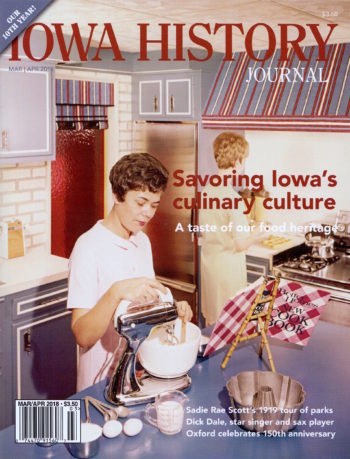
Better Homes and Gardens Test Kitchen circa late 1960s. Features Carol Miller (left), assistant test kitchen director at the time and Kay Cargil (right), test kitchen home economist. Photo courtesy of Meredith Corporation and Darcy Dougherty Maulsby
By Darcy Dougherty Maulsby
What defines Iowa food or Iowa’s culinary history? Pose this question to a non-Iowan, or even a long-time Iowan, and the first response is often a quizzical look, followed by a long pause. Some people even ask, “Iowa HAS a culinary history?”
Yes, it does. Grounded in Iowa’s rich agricultural heritage and spiced with diverse ethnic influences, Iowa’s culinary history ranges from farm-fresh sweet corn, to hearty meat-and-potatoes mainstays. “We don’t meet if we don’t eat” could be the state’s unofficial motto.
Perhaps one of the most beloved, yet mystifying, examples of Iowa’s culinary heritage is the classic school lunch combination of chili and cinnamon rolls. While the “chili and cinnamon roll” phenomenon seems to be a distinctly Iowa thing, a few other Midwestern states lay claim to it as well, including Nebraska and Kansas. Still, Iowans have practically transformed the combination into an art form.

Photo courtesy of Darcy Dougherty Maulsby
No one knows exactly where the idea of eating cinnamon rolls with chili began, but it has become an obsession for generations of school kids across Iowa. There are variations of this classic combination. In the former Lake City School District, for example, the talented school cooks (including many farm wives who were expert home cooks) started early in the morning on chili day to make their exceptional homemade caramel rolls. The sweet, spicy aroma emanating from the kitchen by midmorning was enough to have every stomach growling.
Other schools in Iowa served cinnamon rolls with white frosting rather than caramel rolls on chili day. Still, other school districts served peanut butter sandwiches with chili. While some Iowa school cafeterias never offered chili and cinnamon rolls together on the menu, this unique tradition continues to delight countless young Iowans in many school districts across the state. This tradition isn’t just for kids, either. In Sioux Center, Casey’s Bakery promotes its famous “Chili Bash,” where homemade chili and cinnamon rolls are served on Thursdays throughout the winter.
TO READ MORE ABOUT THIS STORY AND OTHER FASCINATING STORIES ABOUT IOWA HISTORY, subscribe to Iowa History Journal. You can also purchase back issues at the store.
